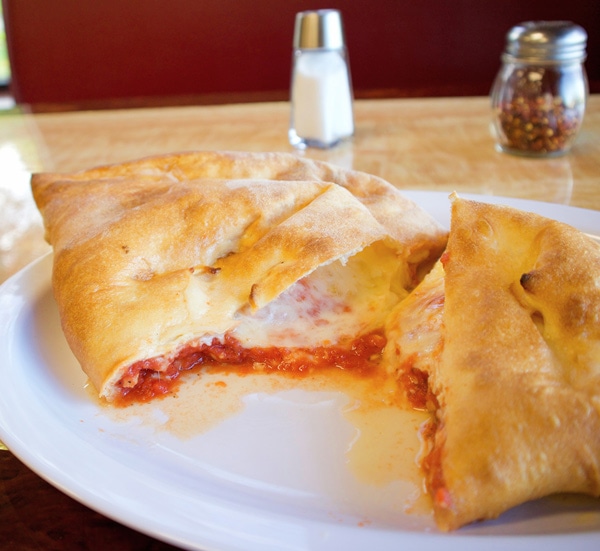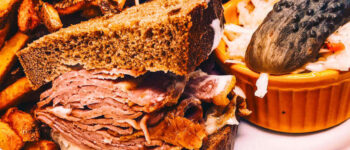In the world of Italian cuisine, few debates are as heated as the one between stromboli and calzone. Both have earned their spots on the tables of families, single men, and casual diners around the world. Their popularity is undeniable, with each having its own legion of loyal fans.
At Tuscan Pizza, we pride ourselves on our diverse menu offerings. From wings and hoagies to cheese-steaks and burgers, we’ve got it all. But today, we’re diving deep into two of our most beloved items: the stromboli and the calzone. Why are they so popular, and what sets them apart?
Before we delve into the intricacies of these two dishes, let’s set the table with a brief overview:
- The origins of stromboli and calzone
- Their rise to popularity in the global culinary scene
- How they’ve become staples in pizzerias, including ours
With that, let’s embark on this flavorful journey and explore the differences between a stromboli and a calzone.
What Is the Difference Between a Stromboli and a Calzone?
The difference between a calzone and a stromboli lies in their shape, sealing technique, and serving style. Here are the key distinctions:
Calzone:
- Shape: A calzone is folded in half, creating a half-moon shape.
- Sealing Technique: The edges of a calzone are pinched together to seal it, creating a pocket that encloses the filling.
- Serving Style: Calzones are typically cut in half and meant to serve one or two people.
Stromboli:
- Shape: A stromboli is rolled like a burrito, resulting in a log or elongated rectangle shape.
- Sealing Technique: Strombolis are always rolled, with the dough wrapped around the filling.
- Serving Style: Strombolis are sliced into multiple servings, making them suitable for serving a crowd.
Both calzones and strombolis are made with pizza or bread dough and filled with cheese and other ingredients. They can be customized with various fillings, including cured meats and vegetables. While they share similarities in terms of ingredients, the shape and sealing technique set them apart.
What Is a Stromboli?
Origin and History
The stromboli, often mistaken for its cousin the calzone, has a history that’s a blend of Italian tradition and American innovation. While its name suggests roots from the Italian island of Stromboli, its actual inception is believed to have taken place in the United States in the 1950s, specifically in Philadelphia, PA. This delightful dish quickly became a favorite, bridging the gap between a sandwich and a pizza.
People tend to think that the Stromboli originated in Essington – a small town right outside of Philly. At the time, it was a predominantly Italian neighborhood. The owner of a small restaurant and pizzeria stuffed cold cuts and cheese into pizza dough and rolled it up. He baked the food and started selling them in masses.
Key Features of Stromboli
So, what exactly is a stromboli? At its core, a stromboli is a type of turnover filled with various Italian cheeses, cold cuts, or vegetables. The outer layer is made from pizza dough, which is then rolled and baked to perfection.
See more : How to Season a Blackstone Griddle (Easy Step by Step Guide)
A typical stromboli recipe might include ingredients like mozzarella, salami, capicola, and pepperoni. However, the beauty of stromboli lies in its versatility. At Tuscan Pizza, for instance, we offer a range of variations, ensuring there’s a stromboli for every palate. Whether you prefer yours with just cheese or loaded with toppings, there’s no wrong way to enjoy a stromboli.
While they may not look it, a Stromboli is a lot closer to a sandwich than a pizza.
Think about any Italian-based hoagie (sub, hero) and what it consists of. Usually, it’s filled with a variety of cheeses and Italian meats like salami or capicola (maybe pepperoni). For the more health-conscious out there, your Italian hoagie might also contain a lot of veggies. The same applies to the Stromboli. Your ingredients are laid out on dough and then rolled into a loaf, and baked.
What Is a Calzone?
Origin and History
The calzone, on the other hand, has deep roots in Italy. Originating from Naples in the 18th century, the calzone (meaning “pant leg” or “trouser” in Italian) was initially a pizza folded in half, making it easier to eat on the go. This portable treat was especially popular among workers as a lunchtime meal.
Often called a pizza turnover, not to be confused with the always delectable panzerotti, a calzone is very similar to pizza.
While many pizzerias sell calzones the size of a medium pie, they were originally sandwich-sized. It’s why so many Italian street vendors specialize in the calzone.
Key Features of Calzone
A calzone is essentially a folded pizza, but with a twist. The outer crust is made of pizza dough, but inside, you’ll find a rich filling of cheeses, meats, and vegetables. The ingredients are sealed within, creating a pocket of deliciousness.
One of the most frequently asked questions we get at Tuscan Pizza is, “Do calzones have sauce inside?” The traditional calzone doesn’t have sauce inside; instead, it’s often served on the side for dipping. However, variations exist, and some modern takes might include sauce within the filling.
Just like the stromboli, the calzone offers endless possibilities. From the traditional ricotta and mozzarella filling to more experimental combinations, there’s a calzone for every taste.
Calzones grew in popularity because they could be eaten while on the go. You may be thinking to yourself, you can also eat pizza on the go. But that wasn’t always the case. In Naples, it was tradition to eat a slice of pizza with a knife and fork.

Stromboli vs Calzone: The Main Differences
See more : Internet Asks: “Does a Frappe Have Caffeine?”
Calzone Stromboli Origin Naples, Italy Philadelphia, PA Tomato Sauce On the side Baked in How it’s made Baked or fried Baked Shape Crescent moon Log
Shape and Presentation
At first glance, a stromboli and a calzone might seem quite similar, but their shapes tell a different story. A stromboli is typically rolled into a cylindrical shape, resembling a long loaf. It’s sliced upon serving, revealing its layered fillings. On the other hand, a calzone is crescent-shaped, reminiscent of a half-moon, with its fillings sealed inside the folded pizza dough. When presented on a plate, the calzone stands out with its golden-brown crust, often accompanied by a side of marinara sauce for dipping.
Ingredients and Fillings
While both dishes use a variety of cheeses, meats, and vegetables, their fillings have distinct differences. A stromboli often includes a combination of Italian cold cuts, such as salami, pepperoni, and capicola, layered with cheese. The calzone, in contrast, traditionally contains ricotta cheese, mozzarella, and other ingredients like ham or spinach. It’s worth noting that while strombolis usually have their ingredients spread throughout, calzones have a more pocket-like filling.
Cooking Techniques
Both stromboli and calzone are baked to achieve a crispy exterior and a gooey interior. However, due to their different shapes and sizes, cooking times may vary. Strombolis, being longer, might require a more extended baking time to ensure even cooking. Calzones, being thicker, need a balanced temperature to ensure the crust is golden without overcooking the fillings. The result? A delightful contrast of textures – crispy on the outside, soft and melty on the inside.
Common Misconceptions
Stromboli vs Pizza
One of the most common misconceptions in the world of Italian-American cuisine is the comparison between stromboli and traditional pizza. While both use pizza dough as a base, their presentation and fillings differ significantly. A stromboli is rolled and filled with layers of cheese, meats, and sometimes vegetables, then baked until golden. In contrast, a traditional pizza is flat, topped with sauce, cheese, and various toppings, and baked to a crispy finish. Think of stromboli as a rolled-up pizza, with its flavors melding together inside.
Pizza Turnover vs Calzone
Another point of confusion is the term “pizza turnover” which is often used interchangeably with calzone. While they share similarities, there are subtle differences. A pizza turnover is generally thinner and might contain sauce inside, while a calzone is thicker, with its sauce typically served on the side. Both are delicious pockets of pizza goodness, but the calzone holds a special place in Italian culinary tradition.
Why Choose Tuscan Pizza?
With so many pizzerias around, what sets Tuscan Pizza apart? It’s our commitment to authenticity, quality, and variety. Our diverse menu ensures that whether you’re in the mood for a stromboli, calzone, or any of our other offerings, there’s something to tantalize your taste buds. Our ingredients are fresh, our recipes time-tested, and our passion for food evident in every bite.
We invite you to explore the delightful differences between stromboli and calzone at Tuscan Pizza. Experience firsthand the flavors, textures, and culinary craftsmanship that go into each dish. After all, the best way to understand food is to savor it.
In the grand debate of stromboli vs calzone, there’s no clear winner. Both have their unique charms, flavors, and histories. Whether you’re a fan of the layered goodness of stromboli or the pocket-filled delight of a calzone, one thing’s for sure: Italian cuisine offers a world of flavors waiting to be explored.
So, why not embark on a culinary journey at Tuscan Pizza? Try both, compare, and perhaps find a new favorite. And remember, whether it’s a stromboli, calzone, or any of our other dishes, you’re in for a treat.
If you liked this article, check out these related posts:
- Calzone vs Panzerotti: What’s the Difference?
- The History of Pizza
- Who Invented Pizza
- How to Make Pizza Dough
- What is Pepperoni Made Of?
- What’s on a Supreme Pizza?
Nigel Gildon editor:Nigel Gildon is the editor of Chef Wayne’s Big Mamou: Chef Wayne’s Big Mamou. He has worked in the publishing industry for many years and has a passion for helping new authors get their work into the hands of readers. 63 Liberty Street * Springfield, MA 01003






